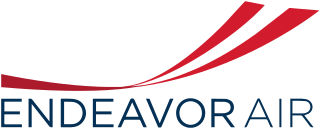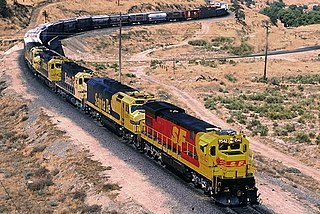Related Research Articles
America West Airlines was an airline in the United States that operated from 1981 until 2007 when it merged with US Airways. It was headquartered in Tempe, Arizona. Its main hub was at Phoenix Sky Harbor International Airport, with a secondary hub at McCarran International Airport in Las Vegas. The airline acquired US Airways in 2005 and adopted US Airways as their brand name. America West served about 100 cities in the US, Canada, and Mexico; flights to Europe were on codeshare partners. In September 2005, the airline had 140 aircraft, with a single maintenance base at Phoenix Sky Harbor International Airport. Regional jet and turboprop flights were operated on a code sharing basis by Mesa Airlines and Chautauqua Airlines as America West Express.

BNSF Railway is the largest freight railroad in the United States. One of six North American Class I railroads, BNSF has 35,000 employees, 32,500 miles (52,300 km) of track in 28 states, and nearly 8,000 locomotives. It has three transcontinental routes that provide rail connections between the western and eastern United States. BNSF trains traveled over 169 million miles in 2010, more than any other North American railroad.

Endeavor Air is a United States regional airline headquartered at the Minneapolis–Saint Paul International Airport in Minneapolis, Minnesota, United States. The airline is a wholly owned subsidiary of Delta Air Lines and staffs, operates and maintains aircraft used on Delta Connection flights that are scheduled, marketed and sold by Delta Air Lines.
US Airways was a major airline in the United States that operated from 1937 until 2015 when it merged with American Airlines. It was originally founded in Pittsburgh as a mail delivery airline called All American Aviation, which soon became a commercial passenger airline. In 1953, it was renamed Allegheny Airlines and operated under that name for a quarter-century. In October 1979, after the passage of the Airline Deregulation Act, Allegheny Airlines changed its name to USAir. A decade later it had acquired Piedmont Airlines and Pacific Southwest Airlines (PSA), and was one of the U.S.'s seven transcontinental legacy carriers. In 1997, it rebranded as US Airways.

The Burlington Northern Railroad was a United States-based railroad company formed from a merger of four major U.S. railroads. Burlington Northern operated between 1970 and 1995.

The Atchison, Topeka and Santa Fe Railway, often referred to as the Santa Fe or AT&SF, was one of the larger railroads in the United States. The railroad was chartered in February 1859 to serve the cities of Atchison and Topeka, Kansas, and Santa Fe, New Mexico. The railroad reached the Kansas–Colorado border in 1873 and Pueblo, Colorado, in 1876. To create a demand for its services, the railroad set up real estate offices and sold farmland from the land grants that it was awarded by Congress.

AMR Corporation was an airline holding company based in Fort Worth, Texas, which was the parent company of American Airlines, American Eagle Airlines, AmericanConnection and Executive Airlines. AMR filed for Chapter 11 bankruptcy protection in November 2011. The company emerged from bankruptcy on December 9, 2013, and at the same time announced that it would merge with US Airways Group to form a new company, American Airlines Group.

The Santa Fe–Southern Pacific merger was an attempted corporate consolidation of two of the major railroads in the Western United States at the time: the Atchison, Topeka and Santa Fe Railway and the Southern Pacific Railroad. The approximately US$5 billion deal was announced in September 1983 and in December 1983, both companies were acquired by a new holding company, the Santa Fe Southern Pacific Corporation and both companies' extensive non-railroad related assets were immediately combined. However, the Southern Pacific Railroad remained in a voting trust and the railroads continued to be operated independently and competitively while the merger worked through the regulatory process.

Mesa Air Group, Inc. is a Nevada Corporation commercial aviation holding company with headquarters in Suite 700 at 410 North 44th Street in the Camelback East area of Phoenix, Arizona, United States. The company operates one regional airline subsidiary: Mesa Airlines which operates as United Express and as American Eagle under contractual agreements with United Airlines and American Airlines respectively.

US Airways Group Inc. was an airline holding company based in Tempe, Arizona. US Airways Group operated US Airways, along with its subsidiaries PSA Airlines, Inc. and Piedmont Airlines, Inc., which are wholly owned but marketed under the branding of US Airways Express. It merged with America West Holdings Corporation, parent of America West Airlines, in 2005, and the combined company adopted the better-known US Airways name; the two airlines' operating certificates merged in 2007. It also operates additional companies that provide associated services. ACE Aviation Holdings, the Canadian parent of Air Canada retained a roughly 6.1% investment stake in US Airways Group. The route network covered destinations in 47 states, as well as international destinations.
Burlington Northern Santa Fe Manitoba is a Canadian subsidiary railroad of the BNSF Railway, which operates in Winnipeg, Manitoba.

Jim Whitehurst is an American business executive. He has been interim chief executive officer and president of Unity Technologies since October 2023. He was previously the president at IBM, chair of the board and chief executive officer at Red Hat, and chief operating officer at Delta Air Lines. Prior to working at Delta in 2001, he was vice president and director of the Boston Consulting Group and held various management roles at its Chicago, Hong Kong, Shanghai and Atlanta offices.
CCAir, Inc. was a regional airline headquartered in Charlotte, North Carolina, United States.
LATAM Airlines Group S.A. is a Chilean airline holding company headquartered in Santiago, Chile. It is considered the largest airline company in Latin America with subsidiaries in Brazil, Colombia, Ecuador, Paraguay and Peru. The company filed for Chapter 11 bankruptcy in the United States on 26 May 2020, due to economic problems attributed to the impact of the COVID-19 pandemic on aviation. Although LATAM Airlines' headquarters are located in Chile, the carrier is an American depositary receipt and traded on both the Santiago Stock Exchange and New York Stock Exchange at the time of bankruptcy. The company's stock ticker (LTMAQ) was delisted from the NYSE and later moved to the unregulated OTC Markets Pink on 12 June 2020.

Thomas W. Horton is a partner of Global Infrastructure Partners and is lead director at Walmart Inc. and General Electric Corp.
United Airlines is the third largest airline in the world, with 86,852 employees and 721 aircraft. It was the brainchild of William Boeing and emerged from his consolidation of numerous carriers and equipment manufacturers from 1928 to 1930.

Delta Air Lines is a major American airline. The company's history began with the world's first aerial crop dusting operation called Huff Daland Dusters Inc., founded in 1925 in Macon, Georgia to combat the boll weevil infestation of cotton crops. C.E. Woolman, general manager and later Delta's first CEO, led a group of investors to acquire the company's assets. Delta Air Service was incorporated on December 3, 1928, and named after the Mississippi Delta region.

Hollis Loyd Harris served as President and COO of Delta Air Lines (1987-1990) and Chairman, President, and CEO of Continental Airlines (1990-1991), Air Canada (1992-1996), and World Airways (1999-2004). According to author Harry Nolan, Harris led the latter three airlines "out of the turbulence of financial instability toward profitability." In 1997 Harris and Steve Wolf signed a strategic agreement between Air Canada and United Airlines, producing what is now the Star Alliance, which grew to become the world's largest global airline alliance.

Leo F. Mullin is an American executive and civic activist who served as CEO and Chairman of Delta Air Lines (1997-2004). He led Delta during one of the most tumultuous periods in aviation history, beginning in 1997, just as airlines were struggling to emerge from the economic crises of the early 1990s. Three years into his tenure as CEO, he also was named Board Chairman of the International Air Transport Association (IATA), representing the world’s airlines. Mullin achieved particular prominence following the September 11, 2001 tragedy when, with the airline industry on the brink of failure, he served as the chief legislative and public spokesperson for the industry’s recovery program. He ended his service to Delta by retiring from his position as CEO in 2003, and as chairman of the board in 2004. After Delta, Mullin has emerged as a leader in both the public and private sectors, serving other companies and continuing to be a philanthropic contributor.

Edward Herman Bastian is an American business executive. He is the ninth and current chief executive officer of Delta Air Lines, serving in this role since May 2, 2016.
References
- ↑ Welty, Gus. ""Our rhetoric was terrific, but the performance wasn't there." (Burlington Northern CEO Gerald Grinstein) (The Competitors) (Cover Story) (Interview)." Railway Age. Simmons-Boardman Publishing Corp. September 1, 1994.
- ↑ "Gerald Grinstein". NNDB. Soylent Communications. 2008. Retrieved 2008-02-28.
- ↑ "An Easter treat". Trains . Kalmbach. February 2023. pp. 56–57.
- ↑ Welty, Gus. "Railroaders of the year: matchmakers Rob Krebs, Jerry Grinstein.(Rob Krebs, president and CEO of Burlington Northern Santa Fe Corp., and former head of Santa Fe prior to the merger; Jerry Grinstein, retired chairman of Burlington Northern Santa Fe Corp.)(Cover Story)." Railway Age. Simmons-Boardman Publishing Corp. January 1, 1996.
- ↑ Coolidge, Alexander. "DELTA IN TRANSITION\ MULLIN ERA COMES TO A SURPRISE CLOSE.(Business)." The Cincinnati Post (Cincinnati, OH). Dialog LLC. November 25, 2003.
- ↑ "Delta Air Lines needs to cut costs, says CEO. (Gerald Grinstein says)(Brief Article)." Airline Industry Information. Normans Media Ltd. March 24, 2005.
- ↑ MICHELE NORRIS. "Congress Looks at Possible Delta-US Air Merger." NPR All Things Considered. National Public Radio. January 24, 2007.
- ↑ "Sign of the times". The Salt Lake Tribune (Salt Lake City, UT). McClatchy-Tribune Information Services. May 2, 2007.
- ↑ William Ruckelshaus, Gerald Grinstein celebrate 80th birthdays with salmon-fishing trip | The Seattle Times Retrieved 2018-12-12.